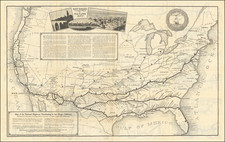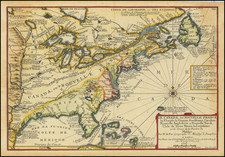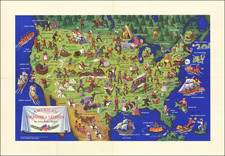Stanford's Map of the United States (Eastern Part) and Cuba with the Central & South American Republics Bordering on the Gulf of Mexico and Caribbean Sea Shewing the European Dependencies in the West Indies &c., produced by Stanford's Geographical Establishment and published in London by Edward Stanford in 1898, offers a detailed representation of the southeastern United States, Cuba, and their neighboring territories. Emphasizing the political dominions of the era, this map delineates British territories in pink while maintaining Cuba under Spanish suzerainty.
The late 19th century marked an era of imperial ambitions, wherein European powers sought to assert and maintain their control over distant lands. The Caribbean and its adjoining regions held strategic value, not just as sources of agricultural wealth, but as crucial points in the interconnected web of global maritime trade and communication. This map, through its meticulous representation, captures the geopolitical stakes of the time, reflecting the dominance of the British Empire in the West Indies, juxtaposed with the diminishing Spanish hold over Cuba in the twilight of its colonial legacy.
A distinguishing feature of this map is its illustration of the submarine telegraph cables, especially the two connecting Havana to Key West. This detail sheds light on the technological innovations of the era and the emphasis on enhancing communication networks for political, economic, and strategic advantages. The presence of these cables signifies the increasing interconnectedness of nations and territories, pointing towards the nascent globalization of the turn of the century.
Furthermore, the map's mounting on linen and its original cloth covers indicate its probable use by professionals, scholars, or travelers of the time. This hints at the growing mobility and exploration trends of the era, supplemented by precise cartographic tools. Through this map, one can not only observe geographical intricacies but also delve into the larger narratives of power, technology, and movement that defined the late 19th century.
Spanish-American War
This map, published in 1898, intersects directly with the timeline of the Spanish-American War, a pivotal conflict that spanned from April to August of the same year. This war saw the United States and Spain clashing over territories in the Caribbean and the Pacific, most notably Cuba and the Philippines, which were then under Spanish colonial rule.
The political landscape represented on this map, particularly the designation of Cuba as Spanish, reflects the situation immediately prior to or at the onset of the war. The struggle for Cuban independence had been ongoing for decades, and U.S. interests, both economic and geopolitical, had steadily grown in the region. The explosion of the USS Maine in Havana Harbor in February 1898 acted as a catalyst, drawing the United States into a direct conflict with Spain over the fate of Cuba.
The inclusion of details such as the submarine telegraph cables connecting Havana to Key West underscores the strategic importance of the region and its infrastructural developments. These communication lines played a significant role during the war, ensuring rapid relay of information between the main territories involved. Such infrastructural developments were not only essential for military strategy but also signified the rising importance of the Caribbean in global communication and trade networks.
By the war's conclusion, the Treaty of Paris was signed in December 1898, leading to the relinquishment of Spanish control over Cuba, Puerto Rico, the Philippines, and Guam to the United States. The portrayal of Cuba as a Spanish territory in this map captures the very brink of this transformative moment, making it a compelling artifact of an era of imperial transition and the reshaping of global power dynamics. This map thus serves as both a geographical and historical testament to the momentous events surrounding the Spanish-American War.
Edward Stanford (1827-1904) was a prominent British mapmaker and publisher. A native of Holborn in the heart of London, Edward was apprenticed to a printer and stationer at the age of 14. After his first master died, he worked with several others, including Trelawny W. Saunders of Charing Cross. Saunders oversaw young Edward’s early career, ensuring that he became a Fellow of the Royal Geographical Society. Associations with the Society eventually brought Sanders much business and gave him a reputation as a publisher of explorers. As testament to this reputation, the Stanford Range in British Columbia was named for him by John Palliser.
Stanford briefly partnered with Saunders in 1852 before striking out on his own in 1853. He was an agent for the Ordnance Survey, the Admiralty, the Geological Survey, the Trigonometrical Survey of India, and the India Office. He also controlled the maps of the Society for the Diffusion of Useful Knowledge, another lucrative source of income. In 1857, Stanford founded his namesake Geographical Establishment, with Saunders and A. K. Johnston as engravers. Thereafter, Stanford was known for his “library maps”, particularly those of Africa and Asia.
Addresses and Years of Operation:
- 6 Charing Cross, London (1848): Edward Stanford's initial place of employment at Trelawney Saunders' shop.
- 7 and 8 Charing Cross, London (1853): Stanford expanded his shop to these addresses.
- 55 Charing Cross, London (1873): The shop moved to this larger location.
- 12-14 Long Acre, London (1873): Site of the new print works and current flagship store.
- 7 Mercer Walk, London (2019): Stanfords moved to this address, continuing its legacy.
Stanford's work with Chief Cartographer John Bolton, including the 1858 Library Map of Europe, positioned the company as a leader in quality cartography during a time of exploration and colonialism. Their 1862 Library Map of London earned acclaim from the Royal Geographical Society. With the business thriving, Stanford purchased Staunton & Son in 1877 and, upon retiring in 1885, handed over the reins to his son, Edward Stanford II.
As sole agents for Ordnance Survey Maps, the company's influence and reputation grew, culminating in the Stanford’s London Atlas Of Universal Geography, which was presented to Queen Victoria in 1887. The transition into the 20th century saw further integration of retail, print, and cartographic operations at Long Acre.
During World War I, Stanford's became an essential publisher for the War Office. Edward Fraser Stanford took over in 1917, steering the company through the interwar period and innovations, such as the world’s smallest maps in 1922 and the Daily Mail Motor Road Map in 1926.
Withstanding a bombing in WWII, the company continued under the stewardship of John Keith Stanford and was sold to George Philip & Son in 1947. As it adapted to the digital age, Stanfords received the Ordnance Survey Premier Partner status in 2007 and ventured into online mapping and data services.
Stanfords, now an icon for travellers and explorers, has maintained its cultural relevance and retail success well into the 21st century, underpinned by a legacy of entrepreneurial spirit and commitment to cartographic excellence.











![Cuba, Jamaica and Porto Rico [Cayman Islands]](https://storage.googleapis.com/raremaps/img/small/78708.jpg)

![Map of Mexico, Central America, and the West Indies [Insets of Bermuda, Cuba, Jamaica and Panama Railroad]](https://storage.googleapis.com/raremaps/img/small/70686.jpg)


![[An English Propaganda Map In French] Carte Des Possessions Angloises & Francoises Du Continent De L'Amerique Septentrionale 1755.](https://storage.googleapis.com/raremaps/img/small/86975.jpg)